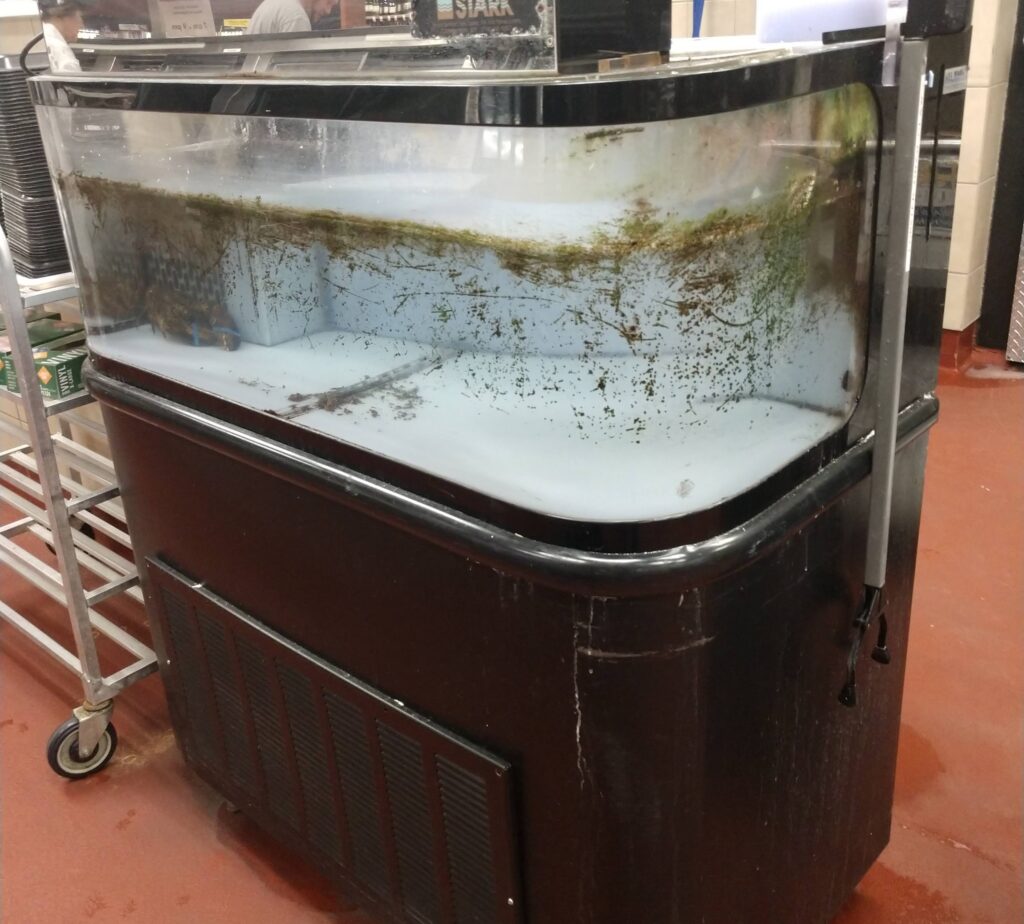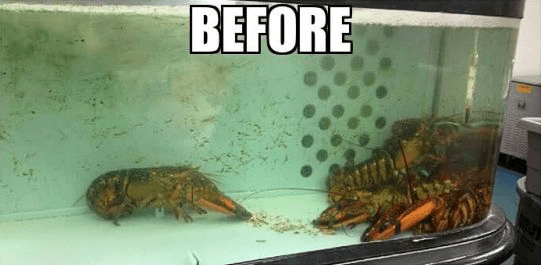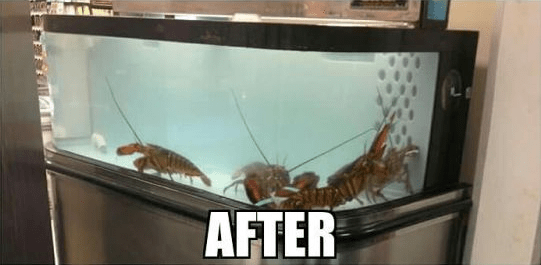
We’ve all seen it. In fact if you’re reading this article you’re challenged with an excessive amount right now and hope to find a cure. First let’s look at what it is, and why it’s there.
There literally are thousands of types of algae, specifically aquarium algae. Remember, your lobster tank is an aquarium! But in this article we’ll focus on the most common Chlorophyta (a fancy word for green, brown and red algae) found in lobster tanks. DON’T PANIC, the algae you see is a sign of a healthy environment. It’s normal, but can be unsightly if not managed properly.
Understand algae is a plant, and needs nutrients to grow. The nutrients to algae growth in a lobster tank are the light source (ambient and tank lighting), lobster waste, and nitrates. These nutrients can not be removed and are naturally occurring within the ecosystem of the tank. Often found in deep scratches throughout the tank, corners, and crevices (of course the hardest to reach areas!) Algae starts out invisible, and will “root” in these areas before it begins to grow. Once it grows is when we start to physically see it with our eyes. Wiping it out, or in worse cases, scraping it off, will remove all the surface growth, but minimally remove the root which is invisible. This is why you’ll feel it’s a never-ending battle, which it is! Most hobbyists, and tank operators are not professionals at getting to the “root” cause and “removing the root”! What we don’t see don’t hurt us right? You’ve heard that plenty of times. Well in this case, it won’t hurt, but it is sure to terrorize you again and again.
Worse yet, a lobster tank with an abundance of algae is a representation of the overall appearance of the seafood dept and its SOP’s (Standard Operating Procedures) in sanitation. A clean tank is a sign of a clean dept. There are many additives on the market to mitigate algae or minimize its growth, most sold in aquarium and big box stores, but BEWARE. These are intended for hobbyist use, and are not food safe. DO NOT use them in your lobster tank as some release chemicals into the water which can be harmful if consumed.
So how do I control it?
Best practices are those that change the pre-filter pad weekly (this is the first filter pad that catches most of the heavy debris in the water) but before discarding will fold the pad inward so the debris is inside the pad. Left side in and right side on top, like a tri fold wallet. Now the debris free side of the pad is exposed and can be used to wipe off the interior surfaces of the tank. If you have a Lobster Life Systems tank, simply remove one of the overflow tubes in tank and let the water drop into the base. Let the tank keep running while you wipe off the interior surface. Because the water is in the base, you can freely (and comfortably) concentrate on the trouble spots and actually remove the algae. Other manufacturers do not have this feature and you may think you’re removing the algae when I fact you’re only getting 50% of it. The remaining is being stirred into the water only to settle somewhere else.
Once you are finished wiping out the interior completely, the pad can be discarded. Doing this on a weekly basis, whether you see it or not, will remove the invisible algae and get to the root before it has a chance to grow. You’ve heard the old saying “an ounce of prevention is worth a pound of cure”. Well in this case cleaning the tank weekly will prevent a more costly and time-consuming task later on.
You should also add a product called Algone. These pouches are filled with all natural organic matter that absorb (not release) the nutrients algae feeds on. Algone is food safe as it is absorbative, and does not release anything harmful into the water. You can buy Algone and Algae Scrapers, or Brush from our Online store, or check with the distributor you buy your paper/packaging products & tank supplies from. They may carry it. If not, contact us and we will try and get it into their product portfolio.
My tank is out of control and I don’t have time to get it clean. What can I do?
Call us or contact us and schedule a deep cleaning. One of our six “Aquaholics” will get rid of that ugly plant and make your tank look sparkling clean. (201)398-0303


We actually get to the “root” cause! (Pun intended.)
